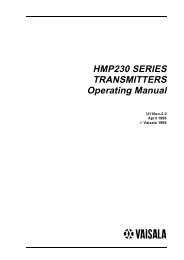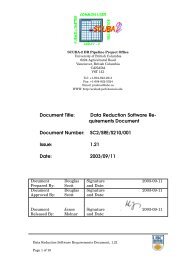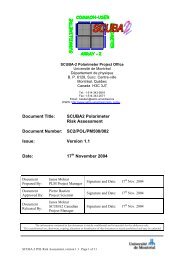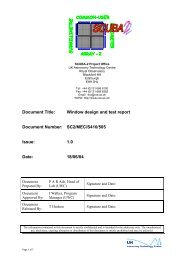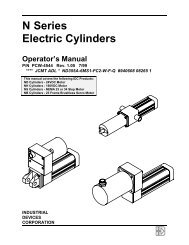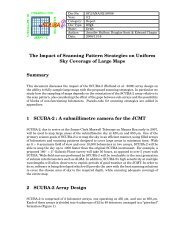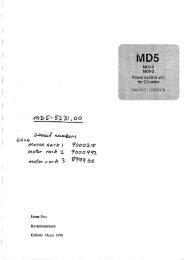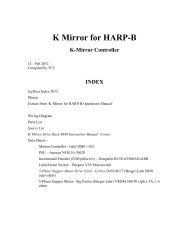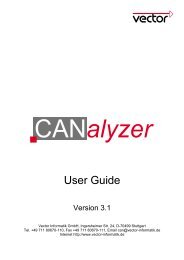Requirements Document Template for the Polarimeter - JACH
Requirements Document Template for the Polarimeter - JACH
Requirements Document Template for the Polarimeter - JACH
You also want an ePaper? Increase the reach of your titles
YUMPU automatically turns print PDFs into web optimized ePapers that Google loves.
SCUBA-2 FTS Project Office<br />
University of Lethbridge<br />
Physics Department<br />
4401 University Drive<br />
Lethbridge, Alberta<br />
CANADA<br />
T1K 3M4<br />
Tel: 1-403-329-2771<br />
Fax: 1-403-329-2057<br />
Email: brad.gom@uleth.ca<br />
WWW: http://research.uleth.ca/scuba2/<br />
<strong>Document</strong> Title:<br />
SCUBA-2 FTS <strong>Requirements</strong> <strong>Document</strong><br />
<strong>Document</strong> Number: SC2/FTS/SYS/001<br />
Issue: Version 1.0<br />
Date: 17 June 2003<br />
<strong>Document</strong><br />
Prepared By:<br />
<strong>Document</strong><br />
Approved By:<br />
<strong>Document</strong><br />
Released By:<br />
B. G. Gom<br />
FTS Project Manager<br />
D. A. Naylor<br />
FTS Project Lead<br />
J. Molnar<br />
Canadian Project Manager<br />
Signature<br />
and Date: 17/06/03<br />
Signature<br />
and Date: 17/06/03<br />
Signature<br />
and Date: 17/06/03<br />
SCUBA-2 FTS <strong>Requirements</strong>, version 1.0<br />
Page 1 of 8
Summary<br />
This document presents <strong>the</strong> requirements <strong>for</strong> building an imaging Fourier Trans<strong>for</strong>m<br />
Spectrometer (FTS) <strong>for</strong> use with <strong>the</strong> SCUBA-2 detector system. By combining a<br />
spectrometer with <strong>the</strong> SCUBA-2 detector array it will be possible to obtain,<br />
simultaneously, a spectrum from each point on <strong>the</strong> sky corresponding to individual<br />
pixels in <strong>the</strong> array. The imaging spectrometer will <strong>the</strong>re<strong>for</strong>e open a third dimension in<br />
astronomical observations by providing spectral in<strong>for</strong>mation at each point in <strong>the</strong> object<br />
under study (e.g. galaxy, molecular cloud). While SCUBA-2 will provide unprecedented<br />
morphological in<strong>for</strong>mation about such sources, composition and physical conditions can<br />
only be determined through imaging spectral measurements. The software requirements<br />
<strong>for</strong> this instrument will be presented in a separate document.<br />
Introduction<br />
In <strong>the</strong> simplest type of Fourier spectrometer, <strong>the</strong> Michelson interferometer (see Figure 1),<br />
<strong>the</strong> incoming beam of light (e.g. from <strong>the</strong> telescope) is divided into two beams of equal<br />
intensity by a beamsplitter. After reflection from a fixed and a moving mirror <strong>the</strong> beams<br />
recombine at <strong>the</strong> beamsplitter and are brought to a focus on <strong>the</strong> detector. The signal<br />
recorded by <strong>the</strong> detector as a function of <strong>the</strong> path difference, or delay, between <strong>the</strong><br />
recombining beams is known as <strong>the</strong> interferogram (see Figure 2). The interferogram<br />
represents <strong>the</strong> autocovariance function of <strong>the</strong> incident radiation. Applying an inverse<br />
Fourier cosine trans<strong>for</strong>mation of <strong>the</strong> interferogram yields <strong>the</strong> spectrum of <strong>the</strong> source.<br />
Thus, while in principle <strong>the</strong> design of an FTS is quite simple, obtaining <strong>the</strong> spectrum<br />
requires sophisticated ma<strong>the</strong>matical analysis.<br />
Figure 1. Typical Michelson interferometer. The optical path difference is l 1 -l 2 .<br />
SCUBA-2 FTS <strong>Requirements</strong>, version 1.0<br />
Page 2 of 8
Figure 2. Typical Interferogram showing <strong>the</strong> Zero Path Difference (ZPD) feature.<br />
The mechanical, optical, and software design of <strong>the</strong> SCUBA-2 FTS will be much more<br />
complicated than that of a standard non-imaging FTS. Also, since <strong>the</strong> FTS was not<br />
included in <strong>the</strong> initial design of SCUBA-2, <strong>the</strong> layout of <strong>the</strong> SCUBA-2 feed optics is not<br />
optimal <strong>for</strong> inclusion of an FTS.<br />
Design Options<br />
Possible design options <strong>for</strong> <strong>the</strong> spectrometer have been identified and discussed in <strong>the</strong><br />
document: “SCUBA2_spectrometer_decision_sumary.doc”. Please refer to this document<br />
<strong>for</strong> <strong>the</strong> details of this decision. The four options were:<br />
1) A grating spectrometer<br />
2) An Fabry-Perrot (FP) interferometer, cooled inside <strong>the</strong> SCUBA-2 cryostat<br />
3) An external FP<br />
4) A Fourier Trans<strong>for</strong>m Spectrometer<br />
Options 1 to 3 were deemed impractical, and <strong>the</strong> FTS was chosen as <strong>the</strong> best solution.<br />
Architecture of <strong>the</strong> FTS<br />
The SCUBA-2 FTS will be based on <strong>the</strong> Mach-Zehnder design which has been adopted<br />
<strong>for</strong> <strong>the</strong> SPIRE instrument (of ESA’s Herschel mission) and <strong>the</strong> U of L spectrometer<br />
operating at <strong>the</strong> JCMT. A schematic of a Mach-Zehnder FTS is shown in Figure 3.<br />
Radiation from <strong>the</strong> input ports passes through an equal intensity beam splitter, is reflected<br />
by stationary mirrors to a moving rooftop mirror, and <strong>the</strong>n reflected to a second beam<br />
splitter. In <strong>the</strong> SCUBA-2 FTS, one input will be used <strong>for</strong> <strong>the</strong> astronomical source, <strong>the</strong><br />
o<strong>the</strong>r input <strong>for</strong> a blackbody calibration source, and only one output port will be used.<br />
SCUBA-2 FTS <strong>Requirements</strong>, version 1.0<br />
Page 3 of 8
Figure 3. Schematic of a Mach-Zehnder FTS.<br />
The design of <strong>the</strong> SCUBA-2 FTS is complicated by <strong>the</strong> fact that we do not have access to<br />
a small diameter collimated beam in <strong>the</strong> SCUBA-2 feed optics. In order to construct an<br />
imaging FTS <strong>for</strong> <strong>the</strong> SCUBA-2 system that uses at least one quarter of <strong>the</strong> full array in<br />
each band, <strong>the</strong> following key components are required:<br />
1) Beam splitters: Two intensity beam splitters are required that have equal<br />
transmission and reflection in both <strong>the</strong> 450 and 850 bands. The target is to image<br />
one quarter of <strong>the</strong> full SCUBA-2 beam through <strong>the</strong> FTS, <strong>the</strong>re<strong>for</strong>e <strong>the</strong> beam<br />
splitters will need to be large enough to accommodate one quarter of <strong>the</strong> full<br />
SCUBA-2 beam at <strong>the</strong> outside of <strong>the</strong> elevation bearing after it has been suitably<br />
collimated (~300 mm). Cardiff should be able to provide 300 mm beamsplitters,<br />
although none have yet been manufactured of this size. Manufacture of larger<br />
diameters may be possible with some retooling of <strong>the</strong> Cardiff shop.<br />
2) Blackbody: A large aperture variable temperature cryogenic blackbody source<br />
will be required <strong>for</strong> calibration, reducing <strong>the</strong> power loading on <strong>the</strong> bolometers,<br />
and possibly <strong>for</strong> canceling out <strong>the</strong> large signal swings as <strong>the</strong> interferometer scans<br />
through <strong>the</strong> zero path difference (ZPD) position.<br />
3) Pickoff mirrors: Since <strong>the</strong> beam is not collimated between mirrors C3 and N1,<br />
and <strong>the</strong>re is not enough space to place an FTS directly in <strong>the</strong> beam, pickoff and<br />
return mirrors will be required to collimate <strong>the</strong> desired portion of <strong>the</strong> beam, pass it<br />
through <strong>the</strong> spectrometer, and return it to mirror N1 in its original state. These<br />
mirrors will need to be on a motorized stage so that <strong>the</strong>y can be removed from <strong>the</strong><br />
beam when <strong>the</strong> FTS is not in use.<br />
4) Linear Stage: The moving rooftop mirrors will need to be large enough to<br />
accommodate <strong>the</strong> desired 300 mm beam, and will likely be quite massive. (If <strong>the</strong>y<br />
are made from aluminum and not lightweighted, <strong>the</strong>n <strong>the</strong> mass could be as large<br />
as 70 kg.) The linear stage must have a suitable load capacity, be powerful enough<br />
to accelerate <strong>the</strong> mirrors (~1 m/sec 2 ), and have a positional accuracy of 1 um or<br />
better. The required acceleration is not yet known, as possible FTS observing<br />
modes are still being investigated.<br />
SCUBA-2 FTS <strong>Requirements</strong>, version 1.0<br />
Page 4 of 8
Figure 4 shows a potential mechanical layout of <strong>the</strong> FTS, mounted just outside <strong>the</strong> left<br />
Nasmyth elevation bearing. More images can be found on <strong>the</strong> U of L SCUBA-2 FTS<br />
webpages.<br />
Figure 4. Conceptual model of <strong>the</strong> FTS mounting location. SCUBA-2 optics are shown in red.<br />
Interfaces with SCUBA-2 and JCMT<br />
Mechanical interface: The FTS will sit within <strong>the</strong> mounting framework <strong>for</strong> mirror N1,<br />
and will likely encroach on <strong>the</strong> receiver cabin access walkway. There should be adequate<br />
protection provided <strong>for</strong> <strong>the</strong> two fixed mirrors that will be nearest to <strong>the</strong> walkway so that<br />
<strong>the</strong>y are not disturbed by passing traffic. Alternatively, <strong>the</strong> walkway may need to be<br />
extended. The entire FTS will be protected by a cover to prevent <strong>the</strong> accumulation of<br />
dust. The mass of <strong>the</strong> FTS is roughly estimated to be 600 kg, and <strong>the</strong> volume will be<br />
approximately 3 m x 1 m x 1.3 m. The JAC should prescribe limits <strong>for</strong> <strong>the</strong> inertial <strong>for</strong>ces<br />
in all three axes that <strong>the</strong> FTS can exert on <strong>the</strong> mount during operation in order to prevent<br />
misalignment of mirror N1.<br />
Operation of <strong>the</strong> FTS will consist of moving <strong>the</strong> pickoff mirrors into <strong>the</strong> SCUBA-2 beam,<br />
scanning <strong>the</strong> moving mirror assembly to acquire interferogram data, and <strong>the</strong>n retracting<br />
<strong>the</strong> pickoff mirrors once FTS observations are complete.<br />
Electronics. Construction of <strong>the</strong> FTS will require very little custom electronics; <strong>the</strong><br />
major electronic component is <strong>the</strong> microcontroller based motion controller <strong>for</strong> <strong>the</strong><br />
moving mirror linear stage and <strong>for</strong> <strong>the</strong> pickoff mirrors. The motion controller and<br />
electronics <strong>for</strong> <strong>the</strong> blackbody source will be interfaced to a control PC. This PC will be<br />
interfaced with <strong>the</strong> SCUBA-2 network so that <strong>the</strong> 32 bit stage position is recorded in <strong>the</strong><br />
header of each frame when an FTS observation is in progress.<br />
SCUBA-2 FTS <strong>Requirements</strong>, version 1.0<br />
Page 5 of 8
Software. The FTS control PC will take commands from <strong>the</strong> RTS Client to initiate a<br />
scan, and will send commands to <strong>the</strong> motion controller to move <strong>the</strong> mirror at <strong>the</strong> required<br />
speed and distance, and return <strong>the</strong> mirror position to <strong>the</strong> software pipeline. The control<br />
PC will also monitor <strong>the</strong> various limit switches and FTS housekeeping parameters.<br />
The display provided to <strong>the</strong> observer by <strong>the</strong> FTS instrument control software should<br />
include <strong>the</strong> following in<strong>for</strong>mation:<br />
• Status of <strong>the</strong> instrument; i.e. position of <strong>the</strong> pickoff mirrors, position and velocity<br />
of <strong>the</strong> moving mirror, blackbody temperature, time remaining, etc.<br />
• A real-time image of <strong>the</strong> array; i.e. from <strong>the</strong> standard SCUBA-2 quicklook<br />
display.<br />
• A means to display <strong>the</strong> last interferogram from a given pixel, as well as <strong>the</strong><br />
corresponding spectrum, <strong>for</strong> data quality assessment.<br />
The rest of <strong>the</strong> in<strong>for</strong>mation (source name, position in <strong>the</strong> sky, sidereal time, etc.) should<br />
all be given on <strong>the</strong> main SCUBA-2 display(s).<br />
The FTS data processing will be per<strong>for</strong>med within <strong>the</strong> SCUBA-2 data analysis pipeline.<br />
This FTS-specific code will be written by <strong>the</strong> U of L team, in close communication with<br />
<strong>the</strong> data analysis software group. An FTS software requirements document will describe<br />
<strong>the</strong>se software issues.<br />
Testability<br />
a) In preparation <strong>for</strong> a normal shift:<br />
Once <strong>the</strong> FTS pickoff mirrors have been moved into <strong>the</strong> beam, and <strong>the</strong> image<br />
quality verified, <strong>the</strong> FTS operation can be tested by per<strong>for</strong>ming a scan of <strong>the</strong><br />
external SCUBA-2 flat-field source. If <strong>the</strong> moving mirror operates properly, <strong>the</strong>n<br />
<strong>the</strong> resulting interferograms and spectra can be inspected to determine if <strong>the</strong> FTS<br />
per<strong>for</strong>mance is acceptable. The various housekeeping parameters monitored by<br />
<strong>the</strong> FTS control PC will indicate if <strong>the</strong>re are problems with <strong>the</strong> instrument or <strong>the</strong><br />
FTS blackbody.<br />
b) As part of routine maintenance:<br />
The FTS linear stage contains precision rails and bearings that will need to be<br />
lubricated periodically, and inspected <strong>for</strong> wear. On a yearly basis, or after any<br />
maintenance, <strong>the</strong> linear stage and optical alignment should be checked using a<br />
laser.<br />
c) During development:<br />
The FTS will be fully assembled and tested in <strong>the</strong> lab prior to commissioning, but<br />
<strong>the</strong>re will be extra alignment tests required during installation at <strong>the</strong> JCMT. Image<br />
quality tests will have to be done on <strong>the</strong> overall SCUBA-2 optical alignment with<br />
<strong>the</strong> FTS in <strong>the</strong> beam.<br />
SCUBA-2 FTS <strong>Requirements</strong>, version 1.0<br />
Page 6 of 8
Responsibilities<br />
The U of L will acquire and/or produce all <strong>the</strong> mechanical and optical components<br />
required to build <strong>the</strong> FTS, as well as <strong>the</strong> FTS control PC. The optical and mechanical<br />
design will be done at <strong>the</strong> U of L. The optics, blackbody, linear stage, optical breadboard,<br />
and o<strong>the</strong>r components will be purchased from suitable vendors, but <strong>the</strong>re will be many<br />
mechanical components and mounts that will be manufactured at <strong>the</strong> U of L.<br />
Software to control <strong>the</strong> FTS, as well as <strong>the</strong> data reduction routines, will be provided by<br />
<strong>the</strong> U of L. Provisions must be made so that suitable FTS commands will be delivered to<br />
<strong>the</strong> FTS control PC, and table position values are recorded with each frame. Significant<br />
cooperation will be required with <strong>the</strong> Data Analysis Software group in order to<br />
implement FTS processing in <strong>the</strong> SCUBA-2 software pipeline. Details will be described<br />
in <strong>the</strong> FTS software requirements document.<br />
Dependencies<br />
In<strong>for</strong>mation: Optical, mechanical, electronics and software interfaces (ATC, JAC, UBC)<br />
Approval: JAC and ATC will provide final acceptance of <strong>the</strong> design.<br />
Components: Beamsplitters will be manufactured by Cardiff. The optics will be custom<br />
machined by a suitable shop. Most o<strong>the</strong>r components are easily acquired from<br />
commercial sources.<br />
Infrastructure: Lab space and time at U of L <strong>for</strong> initial construction and testing. Use will<br />
be made of U of L electronics fabrication equipment and personnel.<br />
Funding: Provided by <strong>the</strong> CFI budget.<br />
Risks<br />
• Manufacture of large (>300 mm) diameter beamsplitters should be feasible, but<br />
has not yet been demonstrated.<br />
• Mass of optics is a concern. Manufacture of light weight moving mirrors may add<br />
cost to <strong>the</strong> system. Force limits <strong>for</strong> N1 mirror framework need to be determined.<br />
This risk can be mitigated by reducing <strong>the</strong> acceleration of <strong>the</strong> linear stage.<br />
SCUBA-2 FTS <strong>Requirements</strong>, version 1.0<br />
Page 7 of 8
Development time-line (estimates)<br />
Conceptual Design Review July 2003<br />
Preliminary Design Review Early 2004<br />
Critical Design Review Mid 2004<br />
Complete instrument tests Late 2005<br />
Delivery to telescope December 2005<br />
The dates in this timeline are current estimates, and assume no interruption in <strong>the</strong><br />
development cycle. Final delivery to telescope will not occur be<strong>for</strong>e delivery of SCUBA-<br />
2 and <strong>the</strong> associated optics.<br />
SCUBA-2 FTS <strong>Requirements</strong>, version 1.0<br />
Page 8 of 8




